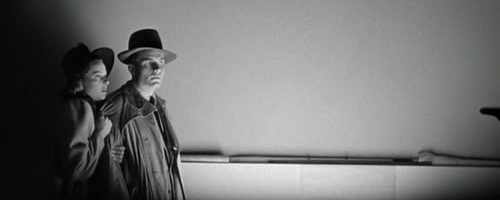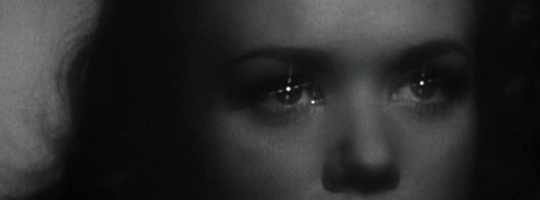Cat People (1942): A Psychological Horror and Film Noir
After a slew of low-budget horror films in the late 1930s, Hollywood hired writer-producer Val Lewton to re-imagine the horror picture. These new films continued to draw from German expressionist style of other well-known horror films such as Dracula and Frankenstein. Unlike these films, Lewton added some Freudian psychoanalytical theories to the mix, like fear of castration or penetration. As a result sex became a major aspect of the horror genre. Another aspect Lewton added was psychological horror. Actual monsters were being substituted for the suggestion of a monster and supernatural atmospheres were traded in for more psychological ones. Sexual imagery, gender role reversal, and more suggested horrors than real scares, this new look at horror provides the missing link from 1930s horror to 1940s film noir.
One famous film that came from this era was Cat People. Directed by Jacques Tourner, the film shares elements of film noir while still staying in the horror spectrum. Like a noir film, Cat People features a femme fatale but unlike noir the femme fatale is also our protagonist. The film focuses on a woman named Irena who lives in fear that if she would ever engage in sex, she would transform into a cat person. This fear stems from a legend from her home country, Serbia. Unable to consummate her marriage Irena also lives in fear that her husband, Oliver will leave her. After a woman named Alice makes an appearance, Irena is forced to release her inner feline. As a result, Alice is soon haunted by a strange black panther. Is this Irena or is it all in Alice’s head?
Expressionist film is all about taking the internal and making it external, meaning taking the emotions and feelings of the characters and pouring them into the design of the film. One example of an expressionist film is The Cabinet of Dr. Caligari. In said film, the architectural design of the film is front center. These films also use irregular and shapes and lines, this is clearly visible in the look of the buildings. The camera also plays into it, they use a variety of high or lower angle shots. But probably the most prominent feature of expressionist film is the lighting. Expressionist films are typically shot in black and white creating a sharp contrast between light and dark. There is also an extensive use of shadows creating a moody and often threatening atmosphere. The same atmosphere can be seen in film noir.

Expressionist lighting is used in Cat People to spectacular effect. In one of the scariest scenes in the film, Alice is being hunted by something, presumably Irena. Oliver and Irena have had difficulties in the past few months, and Irena believes Alice is the cause. Alice decides to go for a swim at an indoor pool at a hotel. While in the locker room Alice senses there is something off. She hears a small kitten and peers outside the locker room to a shadowed staircase. The shadows are large enough and spooky enough that the audience can believe there is something hiding in there. Suddenly, there is a distinct growling from behind the staircase. Alice panics and dives into the pool hoping to scare off anything that’s hiding in the shadows. The pool area is even darker than the locker room and as the camera pans the room there is a distinct shadow moving around the area. Alice screams for help when the lights turn on and Irena is standing by the light switch.
In a later scene, Oliver and Alice are cornered by Irena in a deserted building. While the two are preparing to leave the lights in the room goes out. Alice still a bit jumpy from the pool scene bolts toward the door to find it locked. Oliver still not convinced it was Irena hunting her tells her to relax they can call the janitor, then the growling starts again. Alice hides behind Oliver and much to Oliver’s surprise a blank panther is slinking towards them. Knowing they are doomed, Oliver pleads for Irena to leave them alone. The camera pulls back from the lovers’ faces as they back into the corner. The two of them are surrounded by shadows indicating that they’re about to be swallowed whole by the darkness, literally and figuratively. These lighting choices not only add to the horror but also add to the psychological elements which will be touched on later.

Film noir is a genre of film that came to prominence in the World War II era. These films were traditionally crime dramas and pulled lighting from the expressionist era. These crimes were more often than not sexually motivated. So much so that a common archetype for women in these films was femme fatale or the fatal female. One classic example would be Norma Desmond in Sunset Boulevard. In that film Norma leads the male character, Joe, down the path of darkness through the use of her womanly wiles. Cat People also has a femme fatale, but in a much different capacity. In many ways, a film like Cat People can be seen as a link between expressionism and film noir. It uses expressionist lighting, has a cynic or moody atmosphere, and features a fatale female.
In film noir, the characters that populate the screen often have an obsessive nature. This obsession is often sexual and is the cause of their angst and neurotic mood. Irena fits in this mold nicely. Her obsession with the legend of the cat people leads her to live a very lonely life. She is unable to tell her husband Oliver how she feels about him without immense feelings of guilt and fear. However, according to writer Rick Worland “the notion of film noir whether be considered a genre, a style, or a period, needn’t be strained to include such psychologically tangled vistas as Cat People.” Still, Cat People does have a similar atmosphere to noir films such as Sunset Boulevard.
There are many sexual connotations throughout the film which coincide with Freud’s theories. For example when we are first introduced to Irena she is sketching a picture of panther. Shortly after she meets Oliver, her sketch is blown away by wind and the next time we see it a sword is impaled in the panther. This scene helps illustrates Irena’s fear of sexual penetration. She subconsciously fears that sex will ruin her and make her less than human. The image of the panther illustrates this quite nicely. Despite this, she desires a physical relationship with her husband. Shortly after their marriage, Irena says she wants to be Mrs. Oliver Reed and that means giving herself to him. The two head to separate bedrooms and wish each other a good night. Irena leans against her bedroom door, clearly wanting nothing more than to be with Oliver. She slides to the floor hating herself and the dreaded “curse.”‘

Typically in horror films, the monster is male. Frankenstein’s monster, Dracula, and Nosferatu are all male monsters. Their prey is more often than not, female. Cat People turns that notion on its head, the monster is a woman, a pretty woman at that. Her victims are of both genders, and her attacks are much more personal. The victims of Frankenstein’s monster and Dracula are victims of circumstances, they were simply at the wrong place at the wrong time. Irena’s attacks are emotionally motivated, she is not a threat to the masses but to certain people in her life.
A big question that is raised in the film is whether this legend of the cat people is true. Does Irena suffer from some mental illness? Is her fear just an irrational one? The film never answers it out right. There is one scene where a black panther is seen hunting Oliver and Alice. In other scenes there is growl of a panther but it’s entirely possible that it’s in the characters’ imagination. The audience never sees Irena transform, but we do see Irena take the lock off a panther cage. But in the scene before that some paw prints lead to a very human foot print. The horror in this film could be psychological or it could be supernatural. It’s for the audience to decide.
Cat People is a link between film noir and expressionism through its use of lighting, femme fatale, and moody atmosphere. The film did not invent film noir but perhaps inspired it. Similarly, it was inspired by German expressionism. Films like this go to show that film is often derivative. Directors, writers, and producers all borrow from work that has been done before and in doing so can create something new. Although not a horror film in the classic sense, the horror is suggested not fully shown, Cat People promises to be an interesting ride.
What do you think? Leave a comment.











Very cool comparison.
I like the concept of crossing genres. I have not seen the film but will check it out. You intrigued me.
Thank you! It’s definitely worth a watch.
Nice read, been long since I played this on my TV. The look and tone of the film is completely noir.
Was a good tragedy. It seems to me that a lot of the 30’s and 40’s horror movies were basically tragedies. The original WOLFMAN certainly was. And the Frankenstein monster was actually a tragic figure. Even THE CREATURE FROM THE BLACK LAGOON was tragic.
That’s a very good point! I think that’s one of the reasons I love these older horror movies. There seems to be more character and humanity in them.
Great piece. Although treated as a horror movie, it is effectively a film noir for sure. Irena represents the unknown or other, she is foreign which is what most horror during the mid 40’s was regarded as. The whole film is a play on Americans social anxieties at the time, the fear of the unknown, the paranoia of anything un-American.
Thank you! You’re right! I hadn’t thought about the social anxieties of the time. Thanks for bringing that up.
Great Article! I enjoyed how you gave a general sense of the two genre’s while also rousing my interest in watching the film. Do you have any other recommendations of film’s along the lines of these genres?
Thank you! Tourner and Lewton did another film like this called “I Walked with a Zombie!” Its a bit more on the romantic side but the lighting, atmosphere, and story have a very similar feel.
Cagney,
Nice job on the article, perhaps you can compare and contrast the female role and sexuality in the 1982 remake of Cat People.
That sounds like an excellent idea! I’ll keep that in mind!
hmm this looks like an interesting film, will have to seek it out.
I think this is a great film for noir fans who ordinarily don’t go for horror.
I love horror films, but I don’t like this one because it’s scary in the typical horror movie sense – I love it because it moves me. Simone Simon gives an outstanding performance as Irena, and really makes you feel for her. It’s a complex, emotionally charged story, and in all fairness it’s probably more concerned with that than with actually delivering the scares, which I have no problem with.
I thought it felt very rushed and the plot was a bit silly.
Simone Simon is excellant as the doomed heroine. You really feel for her, and her emotions (from shyness, to happiness at trying to live a normal life, to despair and sadness when she knows it is impossible) are powerful and poignant.
It’s the shadows and the darkness that especially gives Cat People the feeling of noir. Tourneur uses much of the technique he uses in Out Of The Past to create the noir effect.
It is also hard to know if femme-fatalism (for want of a better term) developed in a more or less exclusively psychological dimension (Hitchcock, etc.) at the instigation of this film. In terms of genre-specifics, though, the origination of Noir as an overriding battery of summary techniques has to be seen in Citizen Kane.There, as in his adaption of Kafka’s Trial, a metaphysics of fear is alluded to by means of what is imaginable if one only heard voices on the radio. The link between what we think we hear and what we really see is obvious as a species of exaggeration based upon common experiences of momentary paranoia. After all, we only dream nightmares in black and white.
It is also (lest we forget) an on-the-brink-of-war-as-inevitable film (remembering the interesting lighting in Rick’s semi-dark office above his club in Casablanca). We are surrounded by enemies we cannot see and do not really understand, where the only things knowably apparent are shadows–voices rendered inarticulate thanks to a social convention rendering irony the likely response to fear. In Casablanca, the femme fatale becomes a heroine thanks to the interposition of men willing to sacrifice themselves for their welfare, and this is noble. The femme-fatale in Cats is a woman from an obscure European country who innocently believes in fairy tales, making the point that there is a little of the old country in all of us, so beware of innocence about ideological fervor and easy, magical explanations for things. (There is a dark side to Disney’s “Dumbo,” a film from an identical era that incorporated expressionism and even noir into animation: the nightmares of an inebriated mouse who is incapable of being the hero’s impreessario confirm for us the depth of Dumbo’s ambivalence about the value of freedom, as he becomes subservient to fate through innocence.)
The sinister, in Cats, is reduced to an abstraction thus made an impossible reality. Moviegoers at the time didn’t scream in horror at it, the way children did in the ’50’s when all the old Boris Karlof was being recycled, but were attracted in silence to the intrigue of just that household pet, now and then, one either loves or dislikes for reasons one can’t really explain to oneself.
It is very cool and laid-back like noir, but it isn’t as gritty.
I love that this is a movie that wasn’t supposed to be good. It was a B movie designed to be the more sensationalist, less classy part of a double feature. It’s purely due to the artistry of the director and the studio letting him do what he wanted (since it was so cheap) that this movie was so good and turned into such a surprise hit.
Curse of the Cat People is good too, in a different way! Same characters, but weirdly, no curse and no cats.
This is my favorite horror film of the 1940s. I love the eerie way it is filmed and the subtle sexuality, instead of being in your face. Thanks for writing about it.
The shift to psychological horror seems to have paved the way for Hitchcock in the 50s.